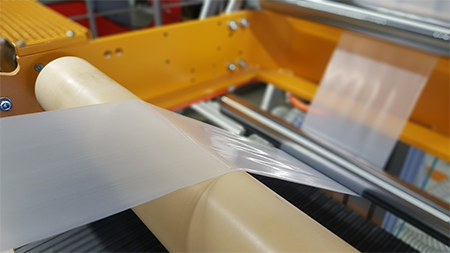| Jun 01, 2021 |
Enzymes successfully embedded in plastics
|
|
(Nanowerk News) In general, plastics are processed at way over a hundred degrees Celsius. Enzymes, by contrast, cannot usually withstand these high temperatures. Researchers at the Fraunhofer Institute for Applied Polymer Research IAP have managed to reconcile these contradictions: They are able to embed enzymes in plastics without the enzymes losing their activity in the process. The potentials this creates are enormous.
|
 |
| Production of a biofunctionalized film in the processing pilot plant. (Image: Fraunhofer IAP)
|
|
Materials that clean themselves, have anti-mold surfaces or are even self-degrading are just a few examples of what will be possible if we manage to embed active enzymes into plastics. But for the enzyme-specific properties to be transferred to the materials, the enzymes must not suffer damage as they are embedded in the plastic.
|
|
Scientists at Fraunhofer IAP have developed a solution to the problem as part of the “Biofunctionalization/Biologization of Polymer Materials BioPol” project. Since summer 2018, the project has been running in cooperation with BTU Cottbus-Senftenberg. The Ministry of Science, Research and Culture of the State of Brandenburg is funding the project.
|
|
“It was clear from the outset that we were not looking to produce biofunctionalized plastics on a laboratory scale. We wanted to take a giant step to show that technical production is possible,” says Dr. Ruben R. Rosencrantz, Head of the “Biofunctionalized Materials and (Glyco)Biotechnology” department at Fraunhofer IAP, summarizing the ambitious project goals.
|
|
At around the midpoint in the project, major breakthroughs are already emerging: Enzymes have been successfully embedded, both in terms of the enzymes themselves and the processing technique.
|
Inorganic protective carriers for higher temperature stability
|
|
Seeking a way to stabilize the enzymes, the researchers use inorganic carriers. These carriers act as a kind of protection for the enzyme. As Rosencrantz explains: “We use inorganic particles, for example, which are highly porous. The enzymes bind to these carriers by embedding in the pores. Although this restricts the enzymes’ mobility, they remain active and are able to withstand much higher temperatures.”
|
|
Rosencrantz does stress, however, that there is no generally applicable stabilization process: “No two enzymes are alike. The carrier and the technology most suitable for the embedding process remain enzyme-specific.”
|
Stabilized enzymes: not only at the plastic surface, but inside too
|
|
The researchers deliberately sought a way of applying the stabilized enzymes not only to the surface of the plastic, but of embedding them into the plastics directly.
|
|
“Although far more difficult, this technique also prevents signs of wear on the material surface affecting the functionality of the plastics,” explains Thomas Büsse who heads the institute’s processing pilot plant for biopolymers in Schwarzheide.
|
|
In order to achieve an optimum material result in the downstream process, the stabilized enzymes have to be distributed as quickly as possible in the hot plastic melt to which they are added, without becoming exposed to excess force or elevated temperatures.
|
|
A balancing act that tipped in Büsse’s favor: “We have developed a process that is suitable for both bioplastics and for the conventional petroleum-based plastics such as polyethylene. Our investigations also show that once embedded in the plastic, stabilized enzymes are able to withstand higher thermal loads than before. This makes the use of enzymes and all process steps considerably easier.”
|
Self-cleaning plastics are just the beginning
|
|
Until now, the researchers at Fraunhofer IAP have evaluated mainly proteases as their choice of enzyme. Proteases are able to break up other proteins. This lends the plastic functionalized by these proteases a self-cleaning effect. Pipes, for example, would not close up or clog as readily. But other enzymes are being systematically tested as well. The cooperation partners at BTU Cottbus-Senftenberg are focusing more closely at enzymes for degrading plastics and toxic substances, for example.
|
|
The first functionalized plastic granulates, films and injection molding bodies have already been produced. The researchers have established that the enzymes embedded in these products remain active. The next step now is to test and further optimize the process for everyday use in various applications. Rosencrantz and Büsse are optimistic — and have also submitted a patent application for their research.
|

